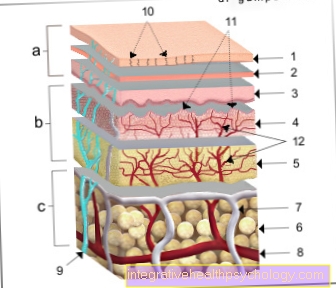What are the side effects of valproic acid?
introduction
Valproic acid, also called valproate, is a medicine used to treat epilepsy, also called seizure disorders. Accordingly, it belongs to the group of drugs called anti-epileptic drugs.
It is a very potent drug, but its mechanism of action has not yet been fully explained.

Why can valproic acid cause side effects?
Valproic acid probably attacks by amplifying inhibitory signals in the neurotransmitter system in the brain. Like all medicines, side effects can occur with valproic acid, some of which are common and some of which are uncommon or very rare in studies.
Find out more about the therapy here: Medicines for epilepsy
Possible side effects of valproic acid
Very often:
- Thrombocytopenia (decrease in blood platelets)
- Leukopenia (decrease in white blood cells)
- Elevations of serum ammonia not clinically relevant
Frequently:
- Weight gain or loss
- Decreased or increased appetite
- Drowsiness and dizziness
- Tremors, sensory disturbances such as tingling or numbness of the skin
- Temporary hair loss
Occasionally:
- Bleeding, headache, confusion
- Tension, unsteady gait, excessive activity
- Stupor (a physical numbness when conscious)
- Organic brain disease that may resolve after weaning
- Diarrhea and excessive salivation,
- Serious liver problems, some of which are fatal (the risk is increased in children),
- Edema (water retention in the tissue)
Rare:
- Lupus erythematosus and vasculitis (immune reactions of the body)
- Renal dysfunction
- Disturbance of brain function including mental performance
- Irregular menstrual periods
- Cystically enlarged ovaries
Very rare:
- Disorder of bone marrow function
- Serious anemia
- Hyponatremia (low levels of sodium in the blood)
- Damage to the pancreas, sometimes fatal
Observed in individual cases:
- Hypersensitivity reactions,
- Eosinophilia
- Pleural effusion
- Illusions, brain disorders, movement disorders
- Ringing in the ears, temporary or permanent hearing loss
- Decrease in bone density (osteoporosis)
- Bed-wetting in children
- Drop in body temperature
Weight gain
Possible side effects of taking valproic acid include increased appetite and consequent weight gain. Some studies suggest that between 20% and 70% of those treated with the anti-epileptic will gain weight. There are many possible causes for the side effect in the therapy:
- A disorder of the so-called neuroendocrine regulatory system (i.e. a hormonal disorder)
- A valproic acid-induced insulin resistance that causes blood sugar to rise
- A reduced breakdown of fatty acids in the blood, which leads to the new synthesis of fat stores
- Decreased physical activity
- Weight gain resulting from excessive calorie intake from these factors
Many factors influence whether patients experience this side effect:
- Gender (women are more often affected than men)
- Phase of life (puberty as the critical point in time)
- Duration and dose of treatment
- Starting weight
- Genetic predisposition
In many patients, weight gain leads to discontinuation of therapy with valproic acid, and being overweight increases the risk of metabolic syndrome and diabetes mellitus.
When introducing therapy with valproic acid, the patient should be informed about the possible side effects and keep an eye on their body weight. Physical activity and a balanced diet can prevent weight gain. However, if the body weight increases significantly, switching therapy to another anti-epileptic should be considered.
You might also be interested in: Calorie-conscious diet
skin rash
Valproic acid can cause various side effects on the skin. A possible but rare side effect of valproic acid is skin rashes. The risk is relatively low in monotherapy, but increases particularly in combination therapy with the anti-epileptic lamotrigine.
Although an allergic reaction is suspected, the mechanism behind the development of rashes is not fully explained. The rash can affect smaller areas, but it can also affect the whole body. In addition, raised skin such as pustules or wheals can occur, as well as itching.
A rare side effect of treatment with valproate is the occurrence of lupus erythematosus, an immune disease. This is accompanied by butterfly-shaped and scaly rashes, especially on the hands.
itching
Itching usually occurs as a side effect of skin rashes during valproate therapy.
If skin reactions such as redness, rash or itching occur, a doctor should be consulted immediately. He or she can stop valproic acid treatment if necessary and prescribe an alternative anti-epileptic drug.
a headache
Occasional headache may occur when taking valproic acid. Interestingly, the drug is also used in off-label use for migraine prophylaxis or for the prevention of cluster headaches, which shows that headaches do not have to occur with every user.
If, in addition to headaches, other neurological symptoms such as dizziness, unsteady gait, visual disturbances, behavioral disorders or even delusions, a doctor should be consulted.
In the most severe cases, taking valproate can lead to so-called encephalopathy (brain disease), which can manifest itself acutely or chronically.
dizziness
Dizziness is a nonspecific symptom and occurs as a common side effect of therapy with valproic acid.
You can often prevent dizziness attacks by slowly straightening up from sitting or lying down, but if you feel dizzy for a long time and severely restricts everyday life, you should consult a doctor.
Visual disturbances
Another possible side effect of therapy with valproic acid are visual disturbances, such as double vision. An externally visible nystagmus (rapid eye twitching) can also occur.
These side effects can occur with virtually all anti-epileptic drugs and affect the ability to drive and use machines. In the event of visual disturbances, the treating neurologist should be consulted.
Tremble
Shaking, known medically as tremor, is a common side effect of taking valproic acid. It can be an isolated symptom and does not necessarily require discontinuation of the drug; however, a tremor can also be an indication of an acute or chronic encephalopathy induced by valproate.
Other accompanying symptoms can increase the suspicion of encephalopathy:
- Difficulty concentrating
- Disorientation, slowdown
- Incontinence
- Asterixis (a twitching fall of the straight arms)
Acute valproate encephalopathy requires discontinuation of therapy and, like chronic valproate encephalopathy, usually resolves completely afterwards. If these or other neurological side effects occur, the patient should definitely consult a doctor.
Hair loss
Temporary hair loss is another common side effect of valproic acid. This presents itself as so-called diffuse hair loss, i.e. affects the entire head. Loss of axillary or pubic hair is less common.
The hair loss manifests itself at the earliest four days to two weeks after starting the intake. The hair loss is only temporary, however, after about one to three months after the end of the treatment, the hair grows back.
Paresthesia
Paresthesia is medically known as paresthesia and can be a common side effect of valproic acid. The sensation is uncomfortable to painful, patients describe various symptoms:
- Tingling sensation, numbness
- Limbs asleep
- Warmth or cold sensations without adequate stimuli
The occurrence and the intensity of the abnormal sensations are dose-dependent, so they increase with an increased intake of the drug. In the event of unpleasant and painful abnormal sensations, the treating neurologist should be consulted.
What side effects can I have when I stop?
Medication should never be discontinued independently by the patient, but always in consultation with a doctor. Sometimes side effects make it necessary to stop taking the anti-epileptic drug. Regardless of this, discontinuation of the drug can be considered even after the recommended two-year period of seizure-free treatment.
In any case, discontinuing anti-epileptic drugs such as valproate is an individual decision that should be made under the supervision of an experienced neurologist. The dose of valproic acid should be reduced gradually, i.e. tapered off. There are currently no indications of any particular side effects when discontinuing valproic acid. However, as with other anti-epileptic drugs, withdrawal attacks can occur, especially if the drug is stopped too quickly.
Lighter types of seizures such as auras can also occur and should stop the withdrawal attempt. The patient should be informed in detail about the withdrawal attempt and the possible risks involved, and should observe regular checks in order to carry it out successfully and with low risk.
You might also be interested in this topic: Epileptical attack





























